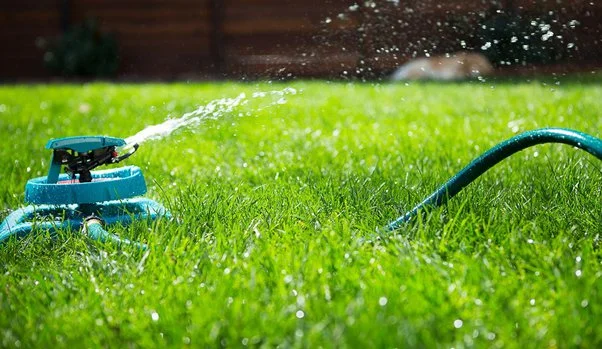Maintaining a healthy, green lawn often comes down to proper watering. To keep your lawn vibrant, water it once or twice a week, providing about 1 to 1.5 inches each time. This method ensures the grass roots grow deeper and stronger, making the lawn more drought-tolerant.
Morning is the optimal time to water your lawn before 10 am, as it allows the water to soak into the soil with minimal evaporation. For those who can’t water in the morning, late afternoon between 4 and 6 pm is also effective, giving the grass blades time to dry before nightfall.
The exact duration of each watering session varies based on several factors, including lawn size and sprinkler type.
Understanding Lawn Watering Needs
Lawn watering requirements vary greatly depending on soil type, grass variety, and local weather patterns. Identifying these factors will help ensure your lawn receives the right amount of water for optimal health.
Determining Soil Type
Different soil types affect water retention and drainage, which impacts how long and how often you should water your lawn. Sandy soils drain quickly but hold less moisture. Lawns with sandy soils may need more frequent watering sessions as moisture escapes quickly.
Clay soils retain water longer, but they can easily become waterlogged. These lawns may require less frequent watering but with longer durations to ensure water reaches the deeper root zones without causing runoff.
Sand, silt, and clay make up loam soils.. As well as providing good drainage, they also retain adequate moisture.. Lawns with loam soil usually need consistent, moderate watering to maintain healthy grass.
Evaluating Grass Varieties
Different grass species have varying watering needs, which should be considered when planning a watering schedule. Cool-season grasses like fescue and bluegrass thrive in moderate climates and require more frequent watering during hot, dry periods to maintain their green appearance.
Warm-season grasses such as Bermuda and St. Augustine are more drought-tolerant and generally need less frequent watering. These grasses can withstand higher temperatures and extended dry spells, reducing the frequency of watering required.
It’s important to know the specific needs of the grass variety in your lawn. Overwatering or underwatering can stress the grass, making it more susceptible to diseases and pests.
Recognizing Weather Patterns
Weather plays a crucial role in determining the watering needs of your lawn. During hot and dry periods, lawns need more frequent watering to compensate for higher evaporation rates. Morning watering between 5:00 am and 10:00 am is recommended to minimize water loss and reduce the risk of fungal growth.
Rainy seasons reduce the need for supplemental watering. Monitoring rainfall helps adjust the watering schedule to avoid overwatering, which can lead to root rot and other issues.
Understanding the local climate and seasonal weather patterns ensures your lawn gets the right water throughout the year, promoting a healthy and resilient landscape.
Effective Watering Techniques
Proper lawn watering ensures lush, green grass and saves water. Below are key strategies, from timing and depth to modern moisture sensors, to help keep your lawn healthy.
Watering Schedules
Establishing a consistent watering schedule is crucial for lawn health. Grass typically needs about 1 to 1.5 inches of water per week, which can come from rainfall or irrigation. It’s best to water early, between 5:00 am and 10:00 am, to minimize evaporation. Evening watering can lead to disease issues as moisture remains on the grass blades, promoting fungal growth. Regular schedules avoid overwatering and reduce costs from unnecessary sprinkler repair.
Deep Watering Method
The deep watering method encourages strong root development by ensuring water penetrates 6 to 8 inches deep into the soil. Watering for 30 minutes, then checking soil moisture by pushing a shovel into the ground, ensures the soil is adequately wet. Adjust the watering time based on soil type, as sandy soils drain faster and may need more frequent watering. This method maximizes water absorption and minimizes runoff.
Utilizing Soil Moisture Sensors
Soil moisture sensors provide precision in watering by measuring soil moisture levels, helping avoid over and underwatering. These devices can be integrated with sprinkler systems to automatically adjust watering times. They are particularly useful for sandy or clay soils with different water retention properties. By providing real-time data, sensors ensure your lawn receives just the right amount of water, enhancing efficiency and reducing the need for frequent sprinkler repair.
The Role of Irrigation Systems
Irrigation systems are crucial in efficiently watering lawns, optimizing water usage, and maintaining healthy grass. Key considerations include choosing an appropriate sprinkler system and ensuring proper maintenance and troubleshooting to keep the system in optimal working condition.
Choosing the Right Sprinkler System
Selecting the right sprinkler system is essential for effective lawn irrigation. Various options include rotary sprinklers, fixed spray sprinklers, and smart irrigation systems. Rotary sprinklers are ideal for large areas because they cover a wide radius with rotating streams of water. Fixed spray sprinklers are well-suited for smaller, specific zones, providing even water coverage.
Smart irrigation systems offer advanced features like weather-based adjustments and remote control via mobile apps. These systems can adjust watering schedules based on weather conditions, ensuring optimal water usage. Factors like lawn size, soil type, and regional climate should influence the choice of sprinkler system to meet your lawn’s needs.
Maintenance and Troubleshooting
Regular maintenance of irrigation systems ensures they work efficiently and minimize water waste. Tasks include checking for leaks, clogs, and broken sprinkler heads. Periodically, inspecting all sprinkler heads for proper alignment and ensuring they are not obstructed is vital.
Cleaning the sprinkler heads can prevent clogs that affect water distribution. For sprinkler repair, addressing issues like malfunctioning timers, low water pressure, or electrical problems may require professional assistance. Timely repairs and calibrations can prevent more significant issues and extend the lifespan of the irrigation system.
Keeping irrigation systems well-maintained helps conserve water, reduce costs, and promote healthier lawns, making the investment worthwhile.

